Optimizing Management Practices to Reduce Sediment Connectivity between Forest Roads and Streams in a Mountainous Watershed
Abstract
:1. Introduction
2. Data and Methods
2.1. Study Area
2.2. Data Acquisition
2.3. Measurement of Sediment Connectivity
2.4. Buffer Analysis
2.5. Optimizing BMPs
2.5.1. Sediment Basin
2.5.2. Riparian Buffer
2.5.3. Mean Change Point Detection
3. Results
3.1. Spatial Relationship between Roads and Streams
3.2. Spatial Distribution of Sediment Connectivity
3.3. Effects of Sediment Basin on Spatial Distribution of Sediment Connectivity
3.4. Effects of Riparian Buffer on Spatial Distribution of Sediment Connectivity
3.5. Determining Optimal Best Management Practices
4. Discussion
4.1. Road–Stream Relationship Influence Sediment Connectivity
4.2. Optimization of Forest Management Measures
4.3. Limitations and Implications
5. Conclusions
Author Contributions
Funding
Data Availability Statement
Acknowledgments
Conflicts of Interest
References
- Surfleet, C.G.; Marks, S.J. Hydrologic and suspended sediment effects of forest roads using field and DHSVM modelling studies. For. Ecol. Manag. 2021, 499, 119632. [Google Scholar] [CrossRef]
- Kazama, V.S.; Corte, A.P.D.; Robert, R.C.G.; Sanquetta, C.R.; Arce, J.E.; Oliveira-Nascimento, K.A.; DeArmond, D. Global review on forest road optimization planning: Support for sustainable forest management in Amazonia. For. Ecol. Manag. 2021, 492, 119159. [Google Scholar] [CrossRef]
- Cao, L.; Zhang, K.; Dai, H.; Liang, Y. Modeling interrill erosion on unpaved roads in the loess plateau of China. Land Degrad. Dev. 2015, 26, 825–832. [Google Scholar] [CrossRef]
- Dietrich, M.; O’Shea, M.J.; Gieré, R.; Krekeler, M.P.S. Road sediment, an underutilized material in environmental science research: A review of perspectives on United States studies with international context. J. Hazard. Mater. 2022, 432, 128604. [Google Scholar] [CrossRef] [PubMed]
- Ramos-Scharrón, C.E. Land disturbance effects of roads in runoff and sediment production on dry-tropical settings. Geoderma 2018, 310, 107–119. [Google Scholar] [CrossRef]
- Touma, B.R.; Kondolf, G.M.; Walls, S. Impacts of sediment derived from erosion of partially-constructed road on aquatic organisms in a tropical river: The Río San Juan, Nicaragua and Costa Rica. PLoS ONE 2020, 15, e0242356. [Google Scholar] [CrossRef]
- Locatelli, B.; Laumonier, Y.; Freycon, V.; Bernoux, M. Soil erosion in the humid tropics: A systematic quantitative review. Agric. Ecosyst. Environ. 2015, 203, 127–139. [Google Scholar] [CrossRef]
- Fidelus-Orzechowska, J.; Strzyżowski, D.; Żelazny, M. The geomorphic activity of forest roads and its dependencies in the Tatra Mountains. Geogr. Ann. Ser. A Phys. Geogr. 2018, 100, 59–74. [Google Scholar] [CrossRef]
- Jing, Y.; Zhao, Q.; Lu, M.; Wang, A.; Yu, J.; Liu, Y.; Ding, S. Effects of road and river networks on sediment connectivity in mountainous watersheds. Sci. Total Environ. 2022, 826, 154189. [Google Scholar] [CrossRef]
- Farias, T.R.L.; Medeiros, P.H.A.; de Araújo, J.C.; Navarro-Hevia, J. The role of unpaved roads in the sediment budget of a semiarid mesoscale catchment. Land Degrad. Dev. 2021, 32, 5443–5454. [Google Scholar] [CrossRef]
- Ramos-Scharrón, C.E. Impacts of off-road vehicle tracks on runoff, erosion and sediment delivery—A combined field and modeling approach. Environ. Model. Softw. 2021, 136, 104957. [Google Scholar] [CrossRef]
- Zhao, Q.; Jing, Y.; Wang, A.; Yu, Z.; Liu, Y.; Yu, J.; Liu, G.; Ding, S. Response of sediment connectivity to altered convergence processes induced by forest roads in mountainous watershed. Remote Sens. 2022, 14, 3603. Available online: https://www.mdpi.com/2072-4292/14/15/3603 (accessed on 22 August 2022). [CrossRef]
- Guo, W.; Bai, Y.; Cui, Z.; Wang, W.; Li, J.; Su, Z. The impact of concentrated flow and slope on unpaved loess-road erosion on the Chinese Loess Plateau. Land Degrad. Dev. 2021, 32, 914–925. [Google Scholar] [CrossRef]
- Zhao, Q.; Zhang, Y.; Xu, S.; Ji, X.; Wang, S.; Ding, S. Relationships between riparian vegetation pattern and the hydraulic characteristics of upslope runoff. Sustainability 2019, 11, 2966. Available online: https://www.mdpi.com/2071-1050/11/10/2966 (accessed on 22 August 2022). [CrossRef]
- Hernani, H. Application of LiDAR DEM Metrics to Estimate Road-Stream Sediment Connectivity in Alberta Eastslopes Salmonid Habitats. Master’s Thesis, University of Alberta, Edmonton, AB, Canada, 2019. [Google Scholar] [CrossRef]
- Sosa-Pérez, G.; MacDonald, L.H. Reductions in road sediment production and road-stream connectivity from two decommissioning treatments. For. Ecol. Manag. 2017, 398, 116–129. [Google Scholar] [CrossRef]
- Llena, M.; Vericat, D.; Cavalli, M.; Crema, S.; Smith, M.W. The effects of land use and topographic changes on sediment connectivity in mountain catchments. Sci. Total Environ. 2019, 660, 899–912. [Google Scholar] [CrossRef]
- Roy, S.; Sahu, A.S. Potential interaction between transport and stream networks over the lowland rivers in Eastern India. J. Environ. Manag. 2017, 197, 316–330. [Google Scholar] [CrossRef]
- Wemple, B.C.; Jones, J.A.; Grant, G.E. Channel network extension by logging roads in two basins, Western Cascades, Oregon. J. Am. Water Resour. Assoc. 1996, 32, 1195–1207. [Google Scholar] [CrossRef]
- Fu, B.; Newham, L.T.; Ramos-Scharron, C. A review of surface erosion and sediment delivery models for unsealed roads. Environ. Model. Softw. 2010, 25, 1–14. [Google Scholar] [CrossRef]
- Eisenbies, M.; Aust, W.; Burger, J.; Adams, M.B. Forest operations, extreme flooding events, and considerations for hydrologic modeling in the Appalachians—A review. For. Ecol. Manag. 2007, 242, 77–98. [Google Scholar] [CrossRef]
- Sosa-Pérez, G.; MacDonald, L. Wildfire effects on road surface erosion, deposition, and road–stream connectivity. Earth Surf. Process. Landf. 2017, 42, 735–748. [Google Scholar] [CrossRef]
- Persichillo, M.G.; Bordoni, M.; Cavalli, M.; Crema, S.; Meisina, C. The role of human activities on sediment connectivity of shallow landslides. Catena 2018, 160, 261–274. [Google Scholar] [CrossRef]
- Lang, A.J.; Aust, W.M.; Bolding, M.C.; McGuire, K.J.; Schilling, E.B. Best management practices influence sediment delivery from road stream crossings to mountain and piedmont streams. For. Sci. 2018, 64, 682–695. [Google Scholar] [CrossRef]
- Rachels, A.A.; Bladon, K.D.; Bywater-Reyes, S.; Hatten, J.A. Quantifying effects of forest harvesting on sources of suspended sediment to an Oregon Coast Range headwater stream. For. Ecol. Manag. 2020, 466, 118123. [Google Scholar] [CrossRef]
- Dangle, C.; Bolding, M.; Aust, W.; Barrett, S.; Schilling, E. Best management practices influence modeled erosion rates at forest haul road stream crossings in Virginia. J. Am. Water Resour. Assoc. 2019, 55, 1169–1182. [Google Scholar] [CrossRef]
- Lu, M.; Zhao, Q.; Ding, S.; Wang, S.; Hong, Z.; Jing, Y.; Wang, A. Hydro-geomorphological characteristics in response to the water-sediment regulation scheme of the Xiaolangdi Dam in the lower Yellow River. J. Clean. Prod. 2022, 335, 130324. [Google Scholar] [CrossRef]
- Solgi, A.; Naghdi, R.; Zenner, E.K.; Hemmati, V.; Behjou, F.K.; Masumian, A. Evaluating the effectiveness of mulching for reducing soil erosion in cut slope and fill slope of forest roads in Hyrcanian forests. Croat. J. For. Eng. 2021, 42, 259–268. [Google Scholar] [CrossRef]
- Luo, H.; Zhao, T.; Dong, M.; Gao, J.; Peng, X.; Guo, Y.; Wang, Z.; Liang, C. Field studies on the effects of three geotextiles on runoff and erosion of road slope in Beijing, China. Catena 2013, 109, 150–156. [Google Scholar] [CrossRef]
- Benda, L.; James, C.; Miller, D.; Andras, K. Road Erosion and Delivery Index (READI): A model for evaluating unpaved road erosion and stream sediment delivery. J. Am. Water Resour. Assoc. 2019, 55, 459–484. [Google Scholar] [CrossRef]
- Lin, H.-Y.; Robinson, K.F.; Walter, L. Trade–offs among road–stream crossing upgrade prioritizations based on connectivity restoration and erosion risk control. River Res. Appl. 2020, 36, 371–382. [Google Scholar] [CrossRef]
- Ramos-Scharrón, C.E.; LaFevor, M.C. Effects of forest roads on runoff initiation in low-order ephemeral streams. Water Resour. Res. 2018, 54, 8613–8631. [Google Scholar] [CrossRef]
- Fressard, M.; Cossart, E. A graph theory tool for assessing structural sediment connectivity: Development and application in the Mercurey vineyards (France). Sci. Total Environ. 2019, 651, 2566–2584. [Google Scholar] [CrossRef] [PubMed]
- Thompson, C.; Hicks, A.; Sun, X. A GIS tool for the design and assessment of road drain spacing to minimize stream pollution: RoadCAT. In Proceedings of the 19th International Congress on Modelling and Simulation, Perth, Australia, 12–16 December 2011; pp. 1923–1929. Available online: http://hdl.handle.net/1885/62462 (accessed on 22 August 2022).
- Mayor, Á.G.; Bautista, S.; Small, E.E.; Dixon, M.; Bellot, J. Measurement of the connectivity of runoff source areas as determined by vegetation pattern and topography: A tool for assessing potential water and soil losses in drylands. Water Resour. Res. 2008, 44, W10423. [Google Scholar] [CrossRef]
- Zingaro, M.; Refice, A.; Giachetta, E.; D’Addabbo, A.; Lovergine, F.; De Pasquale, V.; Pepe, G.; Brandolini, P.; Cevasco, A.; Capolongo, D. Sediment mobility and connectivity in a catchment: A new mapping approach. Sci. Total Environ. 2019, 672, 763–775. [Google Scholar] [CrossRef] [PubMed]
- Borselli, L.; Cassi, P.; Torri, D. Prolegomena to sediment and flow connectivity in the landscape: A GIS and field numerical assessment. Catena 2008, 75, 268–277. [Google Scholar] [CrossRef]
- Zanandrea, F.; Michel, G.P.; Kobiyama, M. Impedance influence on the index of sediment connectivity in a forested mountainous catchment. Geomorphology 2020, 351, 106962. [Google Scholar] [CrossRef]
- Thomaz, E.L.; Peretto, G.T. Hydrogeomorphic connectivity on roads crossing in rural headwaters and its effect on stream dynamics. Sci. Total Environ. 2016, 550, 547–555. [Google Scholar] [CrossRef]
- Kalantari, Z.; Cavalli, M.; Cantone, C.; Crema, S.; Destouni, G. Flood probability quantification for road infrastructure: Data-driven spatial-statistical approach and case study applications. Sci. Total Environ. 2017, 581–582, 386–398. [Google Scholar] [CrossRef]
- Lang, A.J.; Aust, W.M.; Bolding, M.C.; Mcguire, K.J.; Schilling, E.B. Comparing sediment trap data with erosion models for evaluation of forest haul road stream crossing approaches. Trans. Asae Am. Soc. Agric. Eng. 2017, 60, 393–408. [Google Scholar] [CrossRef]
- Kuglerová, L.; Jyväsjärvi, J.; Ruffing, C.; Muotka, T.; Jonsson, A.; Andersson, E.; Richardson, J.S. Cutting edge: A comparison of contemporary practices of riparian buffer retention around small streams in Canada, Finland, and Sweden. Water Resour. Res. 2020, 56, e2019WR026381. [Google Scholar] [CrossRef]
- Arif, M.; Tahir, M.; Jie, Z.; Changxiao, L. Impacts of riparian width and stream channel width on ecological networks in main waterways and tributaries. Sci. Total Environ. 2021, 792, 148457. [Google Scholar] [CrossRef] [PubMed]
- Cole, L.J.; Stockan, J.; Helliwell, R. Managing riparian buffer strips to optimise ecosystem services: A review. Agric. Ecosyst. Environ. 2020, 296, 106891. [Google Scholar] [CrossRef]
- Sirabahenda, Z.; St-Hilaire, A.; Courtenay, S.C.; van den Heuvel, M.R. Assessment of the effective width of riparian buffer strips to reduce suspended sediment in an agricultural landscape using ANFIS and SWAT models. Catena 2020, 195, 104762. [Google Scholar] [CrossRef]
- Dutton, P.D. Factors Influencing Roadside Erosion and In-Stream Geomorphic Stability at Road-Stream Crossings for Selected Watersheds, North Shore, Minnesota, USA. Ph.D. Thesis, University of Minnesota, Minneapolis, MN, USA, 2012. Available online: https://hdl.handle.net/11299/140028 (accessed on 22 August 2022).
- López-Vicente, M.; González-Romero, J.; Lucas-Borja, M.E. Forest fire effects on sediment connectivity in headwater sub-catchments: Evaluation of indices performance. Sci. Total Environ. 2020, 732, 139206. [Google Scholar] [CrossRef] [PubMed]
- Zhao, G.; Gao, P.; Tian, P.; Sun, W.; Hu, J.; Mu, X. Assessing sediment connectivity and soil erosion by water in a representative catchment on the Loess Plateau, China. Catena 2020, 185, 104284. [Google Scholar] [CrossRef]
- Seutloali, K.E.; Beckedahl, H.R. A review of road-related soil erosion: An assessment of causes, evaluation techniques and available control measures. Earth Sci. Res. J. 2015, 19, 73–80. [Google Scholar] [CrossRef]
- Fidelus-Orzechowska, J.; Strzyżowski, D.; Cebulski, J.; Wrońska-Wałach, D. A quantitative analysis of surface changes on an abandoned forest road in the Lejowa Valley (Tatra Mountains, Poland). Remote Sens. 2020, 12, 3467. [Google Scholar] [CrossRef]
- Xu, S.; Zhao, Q.; Liu, Y.; Ding, S.; Qin, M. Sensitivity and applicability of landscape leakiness index in determining soil and water conservation function of a subtropical riparian vegetation buffer zone. Environ. Eng. Sci. 2018, 36, 227–236. [Google Scholar] [CrossRef]
- Zhao, Q.; Ding, S.; Hong, Z.; Ji, X.; Wang, S.; Lu, M.; Jing, Y. Impacts of water-sediment regulation on spatial-temporal variations of heavy metals in riparian sediments along the middle and lower reaches of the Yellow River. Ecotoxicol. Environ. Saf. 2021, 227, 112943. [Google Scholar] [CrossRef]
- Anderson, C.J.; Lockaby, B.G. Research gaps related to forest management and stream sediment in the United States. Environ. Manag. 2011, 47, 303–313. [Google Scholar] [CrossRef]
- Stutter, M.; Costa, F.B.; Ó Uallacháin, D. The interactions of site-specific factors on riparian buffer effectiveness across multiple pollutants: A review. Sci. Total Environ. 2021, 798, 149238. [Google Scholar] [CrossRef] [PubMed]
- Zhao, Q.; Ding, S.; Lu, X.; Liang, G.; Hong, Z.; Lu, M.; Jing, Y. Water-sediment regulation scheme of the Xiaolangdi Dam influences redistribution and accumulation of heavy metals in sediments in the middle and lower reaches of the Yellow River. Catena 2022, 210, 105880. [Google Scholar] [CrossRef]
- Shan, N.; Ruan, X.-H.; Xu, J.; Pan, Z.-R. Estimating the optimal width of buffer strip for nonpoint source pollution control in the Three Gorges Reservoir Area, China. Ecol. Model. 2014, 276, 51–63. [Google Scholar] [CrossRef]
- Cho, J.; Lowrance, R.R.; Bosch, D.D.; Strickland, T.C.; Her, Y.; Vellidis, G. Effect of watershed subdivision and filter width on SWAT simulation of a coastal plain watershed. J. Am. Water Resour. Assoc. 2010, 46, 586–602. [Google Scholar] [CrossRef]


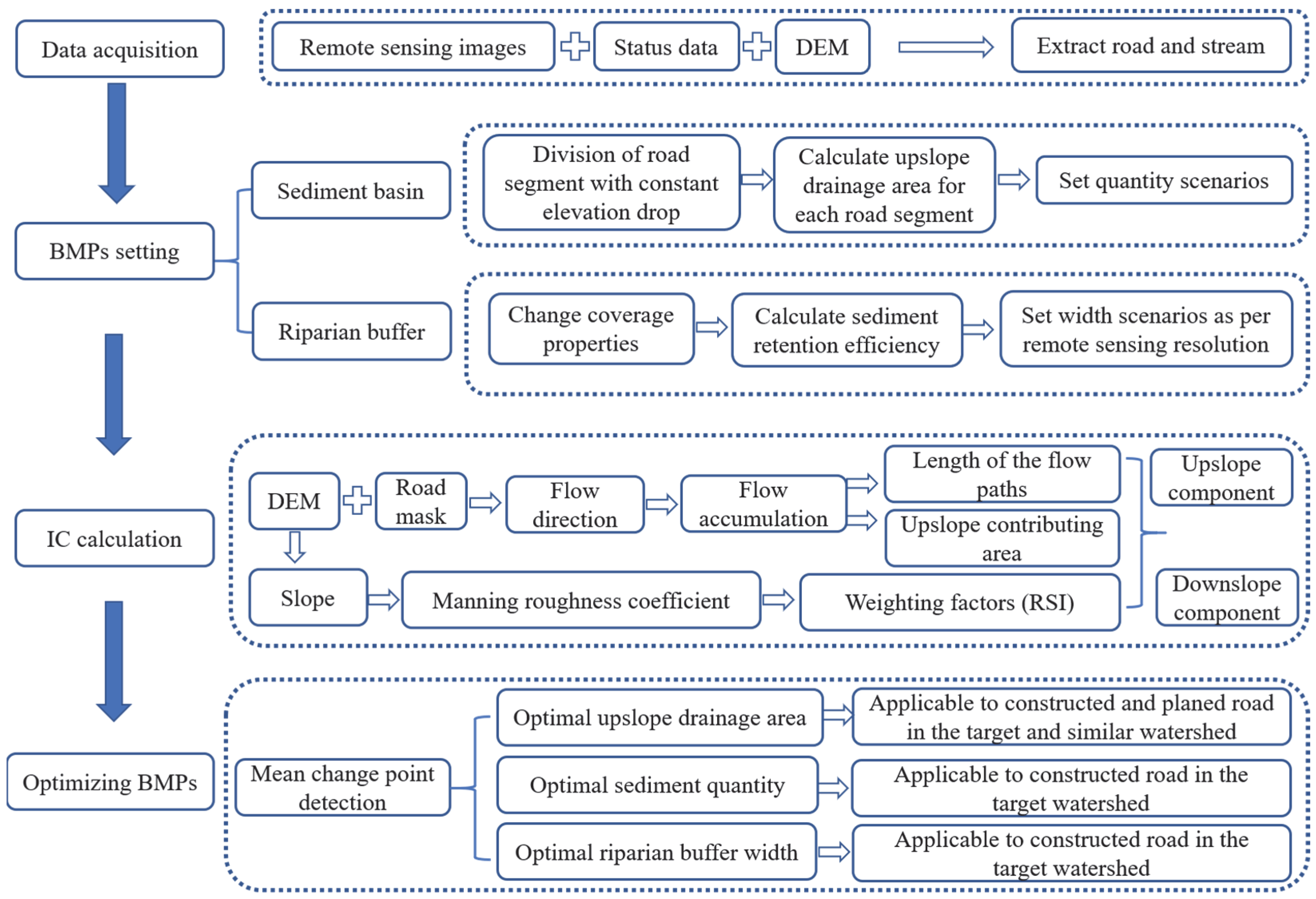
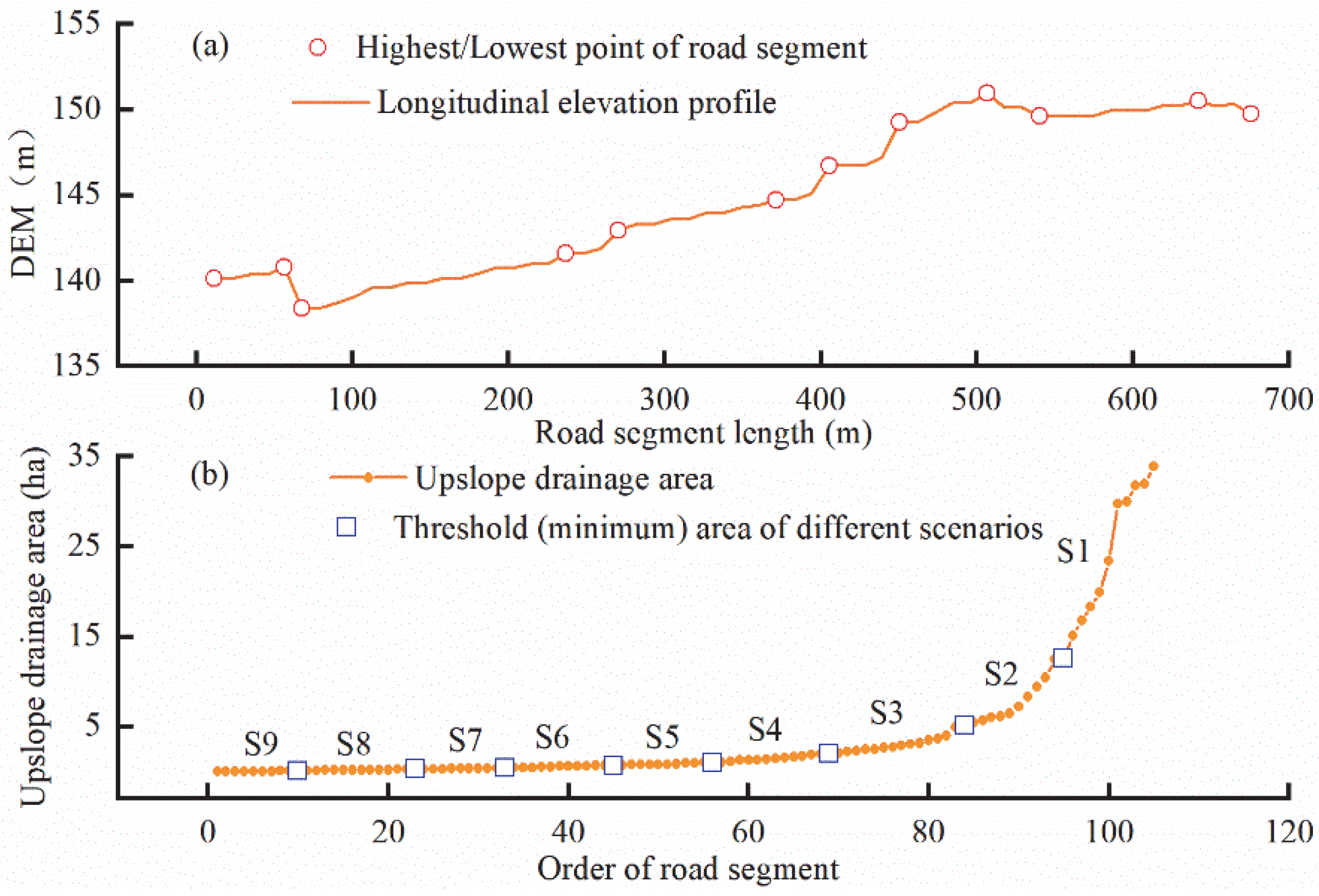
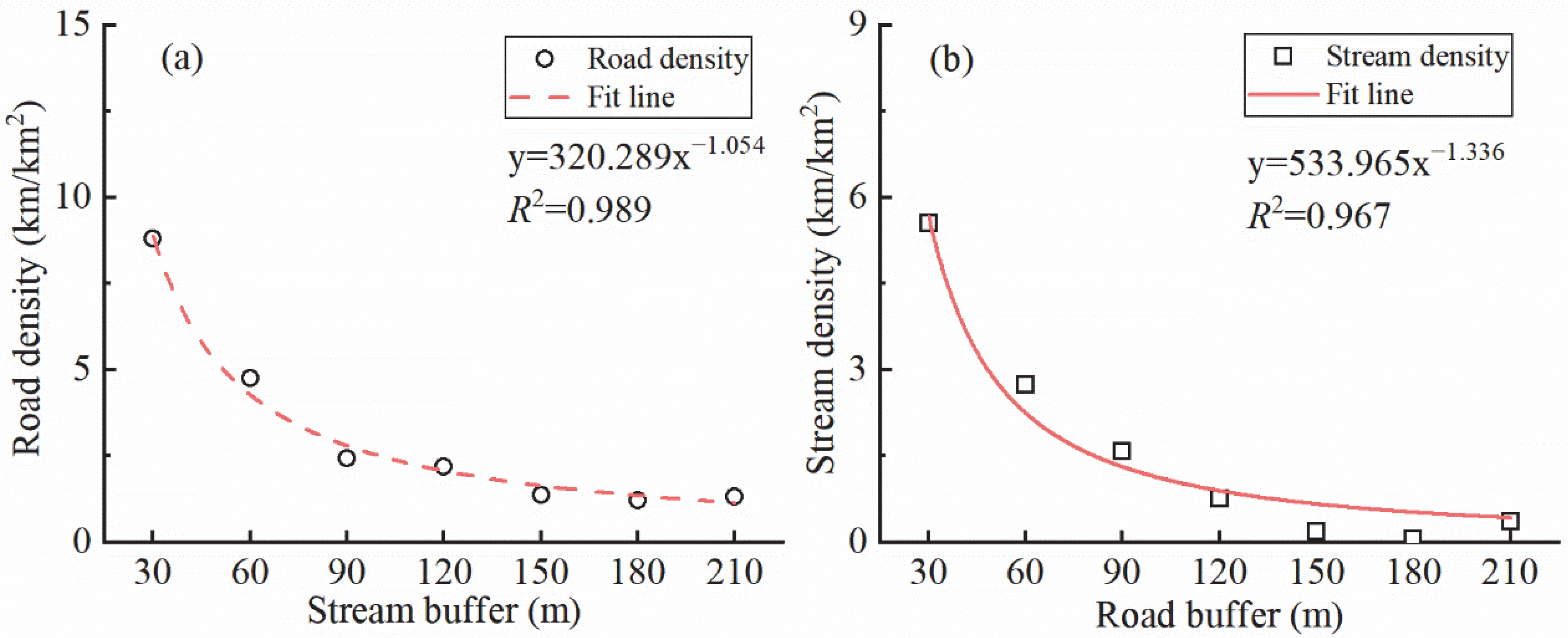
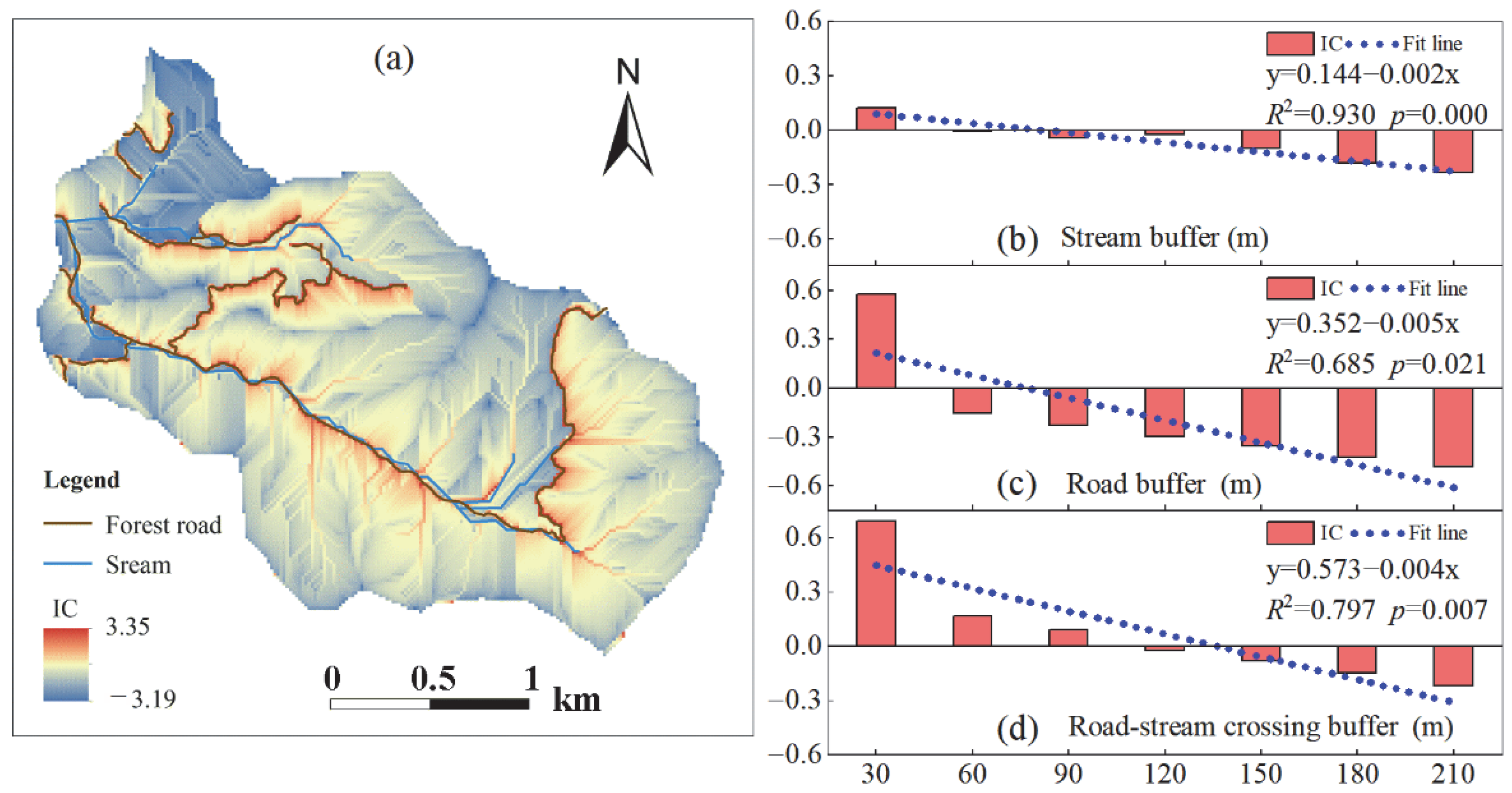
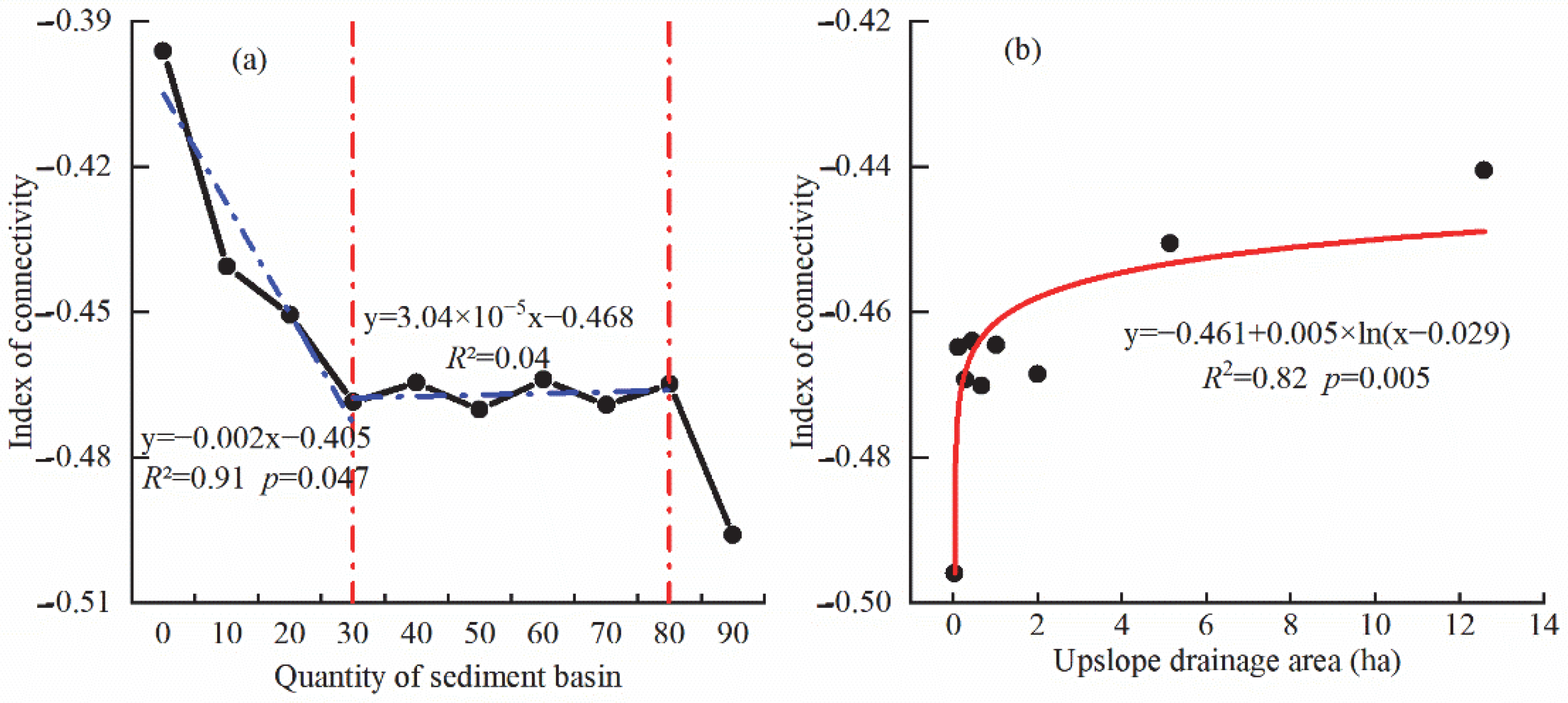


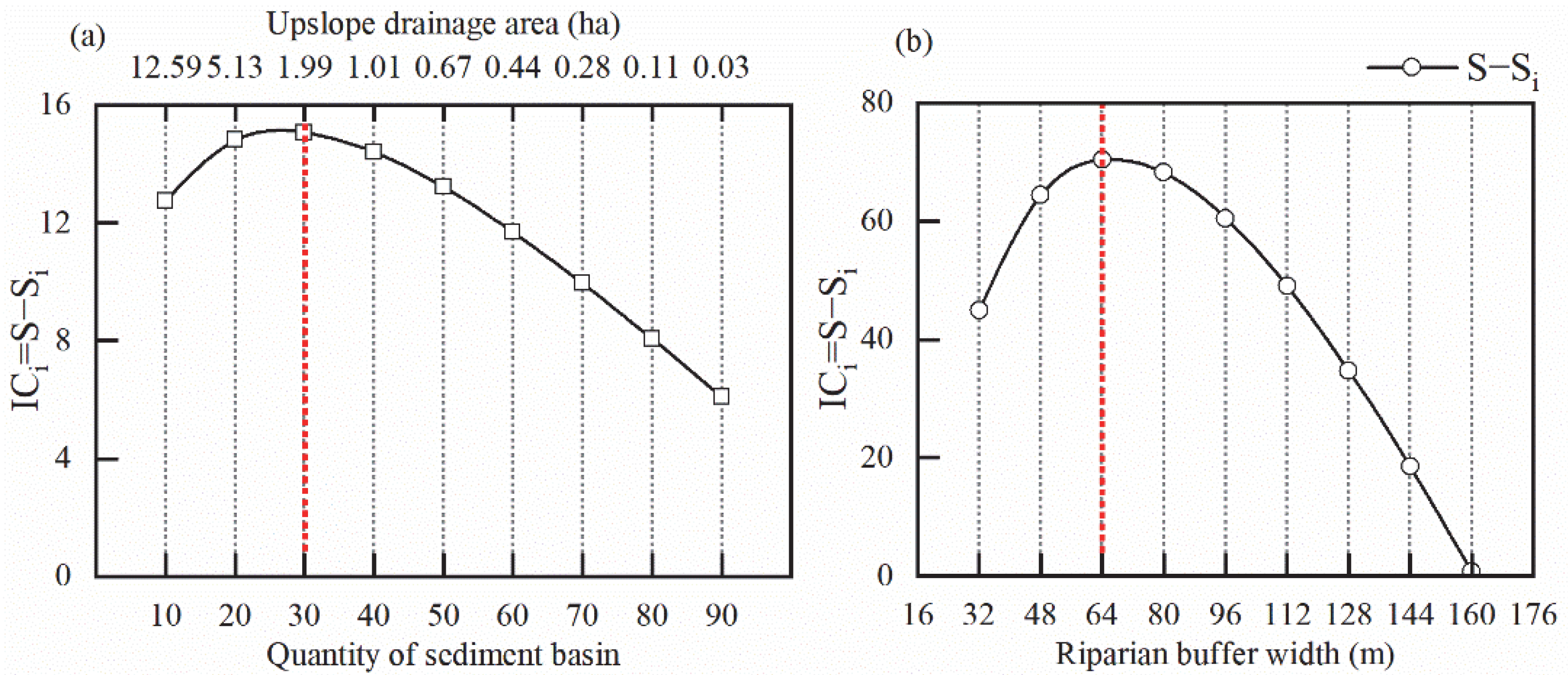
| Indicator | Riparian Buffer Width (m) | |||||||||
|---|---|---|---|---|---|---|---|---|---|---|
| 16 | 32 | 48 | 64 | 80 | 96 | 112 | 128 | 144 | 160 | |
| Sediment retention efficiency Y (%) | 0.170 | 0.267 | 0.322 | 0.353 | 0.372 | 0.382 | 0.388 | 0.391 | 0.393 | 0.394 |
| Sediment transport efficiency y (%) | 0.830 | 0.733 | 0.678 | 0.647 | 0.628 | 0.618 | 0.612 | 0.609 | 0.607 | 0.606 |
Publisher’s Note: MDPI stays neutral with regard to jurisdictional claims in published maps and institutional affiliations. |
© 2022 by the authors. Licensee MDPI, Basel, Switzerland. This article is an open access article distributed under the terms and conditions of the Creative Commons Attribution (CC BY) license (https://creativecommons.org/licenses/by/4.0/).
Share and Cite
Zhao, Q.; Wang, A.; Jing, Y.; Zhang, G.; Yu, Z.; Yu, J.; Liu, Y.; Ding, S. Optimizing Management Practices to Reduce Sediment Connectivity between Forest Roads and Streams in a Mountainous Watershed. Remote Sens. 2022, 14, 4897. https://doi.org/10.3390/rs14194897
Zhao Q, Wang A, Jing Y, Zhang G, Yu Z, Yu J, Liu Y, Ding S. Optimizing Management Practices to Reduce Sediment Connectivity between Forest Roads and Streams in a Mountainous Watershed. Remote Sensing. 2022; 14(19):4897. https://doi.org/10.3390/rs14194897
Chicago/Turabian StyleZhao, Qinghe, An Wang, Yaru Jing, Guiju Zhang, Zaihui Yu, Jinhai Yu, Yi Liu, and Shengyan Ding. 2022. "Optimizing Management Practices to Reduce Sediment Connectivity between Forest Roads and Streams in a Mountainous Watershed" Remote Sensing 14, no. 19: 4897. https://doi.org/10.3390/rs14194897
APA StyleZhao, Q., Wang, A., Jing, Y., Zhang, G., Yu, Z., Yu, J., Liu, Y., & Ding, S. (2022). Optimizing Management Practices to Reduce Sediment Connectivity between Forest Roads and Streams in a Mountainous Watershed. Remote Sensing, 14(19), 4897. https://doi.org/10.3390/rs14194897






